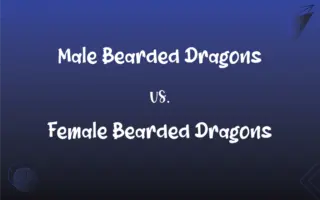Chinese Writing vs. Japanese Writing: What's the Difference?
Edited by Janet White || By Harlon Moss || Published on February 24, 2024
Chinese writing is a logographic system using characters representing words or morphemes, while Japanese writing combines logographic kanji with syllabic kana.

Key Differences
Chinese writing consists of thousands of characters, each representing a word or a morpheme, and is used in various dialects across China. In contrast, Japanese writing uses a combination of kanji, which are borrowed from Chinese characters, and two syllabaries: hiragana and katakana.
The structure of Chinese characters is often complex with numerous strokes, and their meaning is generally not phonetically transparent. Japanese writing, while incorporating these complex kanji, also employs simpler kana characters that directly represent sounds, making it partially phonetic.
In Chinese writing, the same character is used across different dialects, despite pronunciation differences. Conversely, Japanese writing uses kanji for meaning and kana for grammatical elements and pronunciation, reflecting its unique syntax and grammar.
Calligraphy in Chinese writing holds a significant cultural and artistic value, emphasizing the beauty and precision of the characters. Japanese calligraphy also values these aspects, but it includes the distinct flowing styles of kana, adding another dimension to the art form.
Learning Chinese writing requires memorizing a large number of characters, which can be a challenging aspect for learners. Japanese writing, while also requiring the learning of many kanji, is often considered more accessible due to the phonetic nature of kana.
ADVERTISEMENT
Comparison Chart
Character System
Logographic (characters represent words or morphemes)
Mixed (logographic kanji and syllabic kana)
Phonetic Transparency
Generally non-phonetic
Partially phonetic (through kana)
Usage Across Dialects
Uniform characters across dialects
Kanji uniform, but kana reflects specific Japanese phonetics
Calligraphy
Focuses on strokes and structure of characters
Includes kanji and distinct kana styles
Learning Curve
High, due to large number of complex characters
Moderately high, eased by the use of kana
ADVERTISEMENT
Chinese Writing and Japanese Writing Definitions
Chinese Writing
Chinese writing is a logographic system where characters represent words or ideas.
The Chinese writing for peace is 和平 (hépíng).
Japanese Writing
Kana in Japanese writing are phonetic scripts, with hiragana used for native words and katakana for foreign words.
さくら (sakura) in hiragana represents cherry blossoms.
Chinese Writing
Chinese writing is known for its artistic expression in calligraphy.
Chinese calligraphy often features the character 爱 (ài), meaning love.
Japanese Writing
Japanese writing uniquely uses kana for grammatical functions.
The particle は (wa) in a sentence indicates the topic.
Chinese Writing
Each character in Chinese writing is a standalone unit with its own meaning.
In Chinese writing, 水 (shuǐ) means water.
Japanese Writing
Kanji in Japanese writing are borrowed from Chinese characters but often have different pronunciations.
The kanji 水 is read as mizu in Japanese and means water.
Chinese Writing
Chinese writing is used across various dialects, with the same characters having different pronunciations.
The character for mountain, 山, is read differently in Mandarin and Cantonese.
Japanese Writing
Japanese writing combines logographic kanji with syllabic kana.
In Japanese writing, 愛 (ai) and こい (koi) both mean love.
Chinese Writing
Learning Chinese writing involves memorizing thousands of unique characters.
Students of Chinese writing must learn characters like 龍 (lóng), meaning dragon.
Japanese Writing
Japanese calligraphy includes the artful writing of both kanji and kana.
Japanese calligraphy often showcases characters like 平和 (heiwa), meaning peace.
FAQs
Is Chinese writing phonetic?
No, Chinese characters generally do not indicate their pronunciation.
How many characters are in Chinese writing?
There are thousands of characters in Chinese writing.
Are Chinese characters used in Japanese writing?
Yes, Japanese writing uses Chinese characters known as kanji.
Do Chinese characters have multiple pronunciations?
Yes, especially across different Chinese dialects.
Is Japanese writing phonetic?
Partially, due to the use of kana.
Can one read Japanese by knowing Chinese characters?
Only partially, as knowledge of kana is also necessary.
Are new characters still created in Chinese writing?
Rarely, as the existing set is comprehensive.
What is the main component of Chinese writing?
Chinese writing primarily uses logographic characters.
How is grammar indicated in Japanese writing?
Grammar is often indicated through kana and particles.
Is it necessary to learn kanji to be fluent in Japanese?
Yes, kanji is a crucial component of Japanese literacy.
How are names written in Japanese writing?
Usually in kanji, sometimes with hiragana or katakana.
How does Japanese writing represent foreign words?
Through katakana, a syllabic script.
What role does calligraphy play in Chinese writing?
It's a significant artistic and cultural expression.
Is learning Chinese writing harder than learning Japanese writing?
It depends on the learner, but Chinese has more complex characters.
What are the two alphabets in Japanese writing?
The two alphabets are hiragana and katakana.
Can Chinese writing be written vertically?
Yes, traditional Chinese is often written vertically.
Does Chinese writing use spaces between words?
No, Chinese writing does not use spaces.
Are there simplified and traditional forms in Japanese writing?
Japanese uses kanji in both forms, influenced by Chinese reforms.
Is Chinese writing the same in all Chinese-speaking regions?
Yes, the writing system is uniform, though pronunciations differ.
Do meanings of kanji differ in Chinese and Japanese?
Sometimes, due to different cultural and linguistic contexts.
About Author
Written by
Harlon MossHarlon is a seasoned quality moderator and accomplished content writer for Difference Wiki. An alumnus of the prestigious University of California, he earned his degree in Computer Science. Leveraging his academic background, Harlon brings a meticulous and informed perspective to his work, ensuring content accuracy and excellence.
Edited by
Janet WhiteJanet White has been an esteemed writer and blogger for Difference Wiki. Holding a Master's degree in Science and Medical Journalism from the prestigious Boston University, she has consistently demonstrated her expertise and passion for her field. When she's not immersed in her work, Janet relishes her time exercising, delving into a good book, and cherishing moments with friends and family.






































































